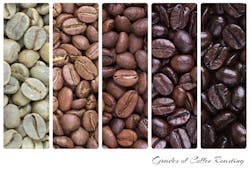There is an idiom that reads, “Beauty is in the eye of the beholder.” The same can be said for coffee blend preference. Does the consumer favor a coffee with distinct origin flavors? Then they are likely to enjoy a light roast blend. What about a coffee with muted acidity, but a little bit of roasted taste? Then perhaps a medium roast. For the consumers who prefer a smoky, bittersweet cup of joe, dark roast will hit the spot. Some consumers describe the dark roast flavor as ‘burnt’. But it doesn’t stop them from drinking it. As a matter of fact, research by the National Coffee Association finds that the majority of coffee consumers opt for the bold, low acidic taste of dark roast coffee: 52 percent.
Big retailers are recognizing this preference, too. In 2014, Dunkin’ Donuts added dark roast coffee to its product line-up, proceeding Tim Horton’s 2013 pilot test of the dark blend in U.S. and Canadian markets. Dark roast coffees contain a strong, smoky flavor, low acidity and a plethora of health benefits. With many dark roast options available, it’s easy to bring this consumer preference for a bold blend into the office.
So what is dark roast coffee?
Dark roast coffee is commonly described as having an intense, full-bodied, bittersweet and bold flavor, largely due to the roasting process. Coffee beans for a dark roast reach internal temperatures of 430°F or higher, compared to the light roast’s internal temperatures of 356 to 401°F. As the temperature of the coffee beans increase, the sugars in the coffee progress from caramelization to a carbonization state, according to Spencer Turer, vice president of Coffee Analysts. “The sweetness and aromatics of the coffee changes from bright and crisp to winy and mellow,” he said. “High quality coffee will still be recognizable at dark roast levels to many people.”
Research shows that darker roasts have less caffeine than lighter ones. As the coffee progresses to dark roast, some of the caffeine changes from a solid to a gas and disperses. However, caffeine content also depends on the type of bean, the grind, the roast and the brew method. “Arabica coffee has about 1.2 percent caffeine and is sweeter and more aromatic than Robusta which has about 2.2 percent caffeine and a stronger, more earthy flavor,” said Turer.
Additionally, dark roast coffee beans lose more than caffeine during the roasting process. Coffee beans lose mass as temperatures increase during roasting, therefore, it takes more dark roasted beans to match the weight of light. In turn, a cup of dark roast coffee will contain more caffeine when brewed by weight. If brewed by volume, however, it’s likely that the dark roast would contain less caffeine than a light roast coffee.
Health benefits
The benefits of dark roast coffee don’t end with the taste. In fact, dark roast coffee has been linked to several health benefits. Research in Molecular Nutrition & Food Research found that dark roast coffee is more effective than light roast coffee in restoring red blood cell vitamin E and glutathione. The same study reported that dark roast coffee led to body weight reduction in pre-obese volunteers. And for those consumers who avoid coffee due to gastric irritation, a 2010 study indicates dark roast blends are better for those with coffee sensitivity.
Dark roast coffee just might be the option that keeps the customer coming back.
About the Author

Adrienne Klein
Contributing Editor
Adrienne Zimmer Klein is a freelance writer with a background in the vending, micro market and office coffee service industry. She worked as an associate editor and managing editor at Automatic Merchandiser and VendingMarketWatch.com from 2013 until 2017. She is a regular contributing writer at Automatic Merchandiser.
